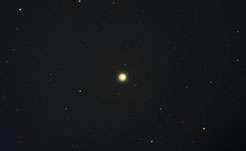Mystery Comet Explodes into Brightness

A once-faint comet has made a sudden leap from obscurity to center stage. Comet 17P/Holmes, now visible to northern hemisphere residents, increased its brightness by a factor of one million this week, going from magnitude 17 to 2. This makes it visible to the unaided eye as well as binoculars and telescopes, offering a unique viewing opportunity for sky watchers.
"This is a terrific outburst," said Brian Marsden, director emeritus of the Minor Planet Center, which tracks known comets and asteroids. "And since it doesn’t have a tail right now, some observers have confused it with a nova. We’ve had at least two reports of a new star."
Comet Holmes is located in the constellation Perseus and is visible for most of the night. In fact, for observers at the latitude of Boston, the comet is circumpolar, never setting below the horizon. In appearance, it resembles a fuzzy, yellowish star.
The comet could fade in a matter of days or weeks, so astronomers recommend that viewers take a look now. Sky charts showing where to look for the comet are online at www.skyandtelescope.com/observ … g/home/10775326.html .
Amateur astronomer Edwin Holmes, who was looking at the Andromeda galaxy at the time, discovered Comet Holmes in 1892. The comet has presented a mystery to astronomers ever since. It likely was undergoing a similar outburst when discovered, since it reached 4th magnitude and was faintly visible to the unaided eye. After fading, it brightened again by a factor of 100 in January 1893 before fading again for good.
The comet orbits the Sun once every 7 years at a distance of about 200 million miles (compared to Earth’s 93-million-mile orbit). As a result, it was re-observed in 1899 and 1906 before being lost for nearly six decades. Based on a prediction by Marsden, the comet was recovered in 1964.
"Since then, it’s been behaving well – until now," says Marsden.
On October 23rd, the comet was a dim 17th magnitude, 25,000 times too faint to be seen with the unaided eye. One day later, it had brightened to 7th magnitude, and the most recent observations peg it at magnitude 2 to 3: an increase of a factor of one million. (The magnitude scale used by astronomers is logarithmic.)
"When the Deep Impact probe hit Comet 9P/Tempel, there was almost no change in brightness," says Marsden. "This outburst by Comet Holmes is extreme!"
Indeed, the outburst has left experts scratching their heads. How could a tiny comet, whose nucleus is no more than two miles across, grow so bright so fast? Perhaps a crack opened in the comet’s surface, exposing fresh ice to the sun and causing an explosive eruption of dust and gas. No one knows for sure. Undoubtedly, professional astronomers will be studying it closely in the weeks to come.
Sky coordinates for Comet 17P/Holmes can be found on the Minor Planet Center website at www.cfa.harvard.edu/iau/Epheme … es/Comets/0017P.html .
Source: Smithsonian Astrophysical Observatory in Cambridge




















